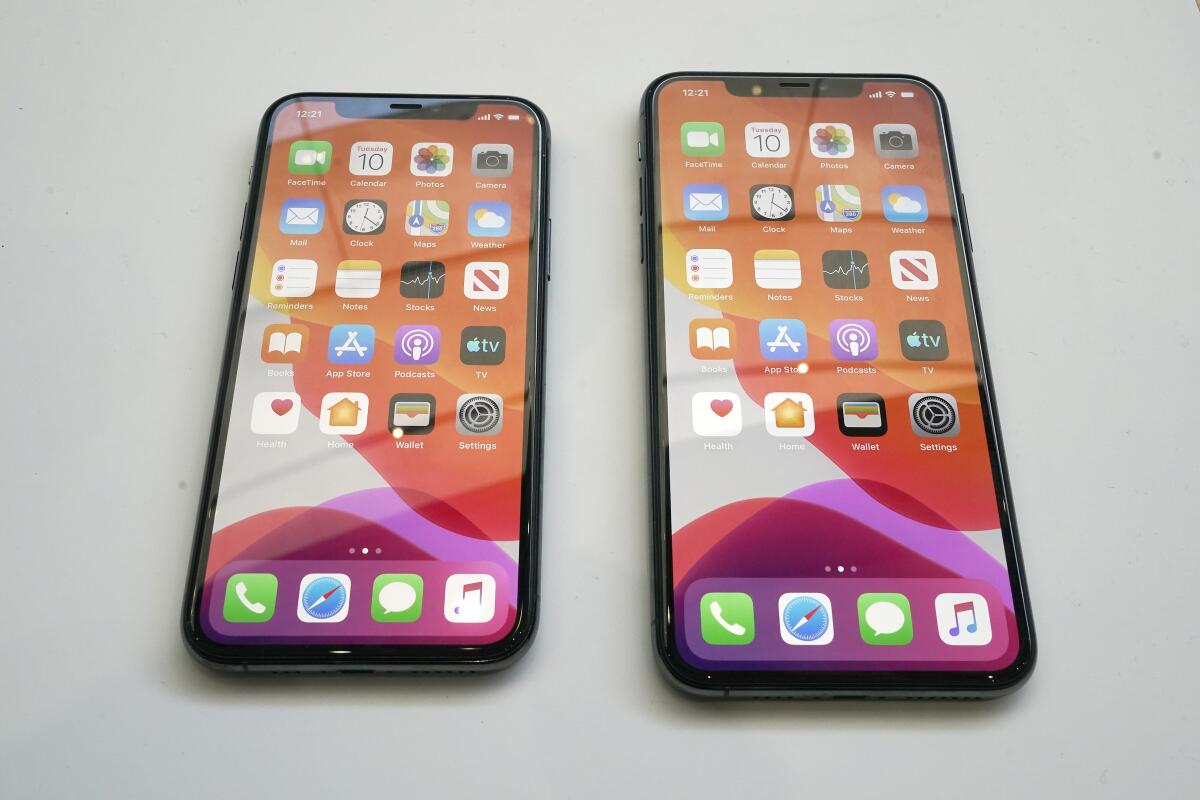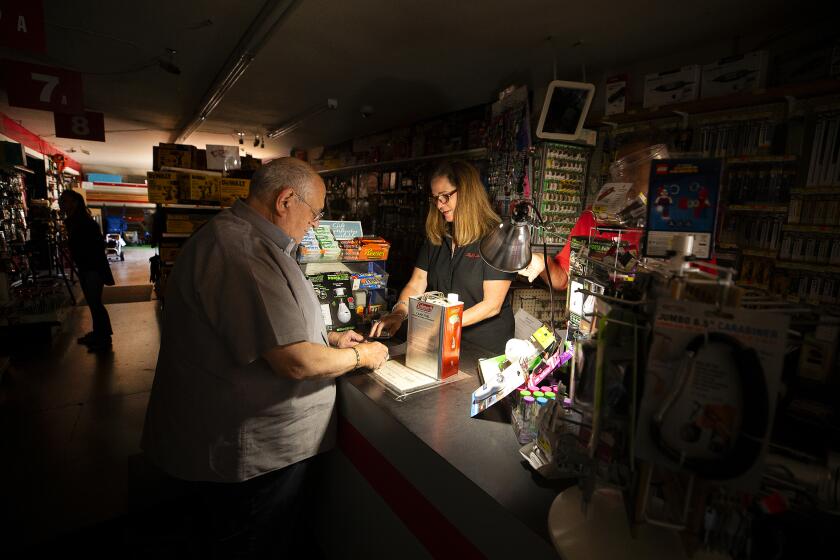PG&E power outage: How to survive with just your cellphone

- Share via
They entertain us, direct us back home from unfamiliar neighborhoods, answer trivial questions. Our cellphones are our lifeline to dozens of daily tasks. But what happens when you need your mobile most — to communicate during a disaster — and find that it isn’t working?
During a disaster such as a wildfire, cellphone towers may burn down or be damaged, as happened during the 2017 wine country fires, when tower after tower went down. Many residents never received county-issued emergency alerts after they’d gone to bed for the night.
Millions of Californians could spend days without power as the state’s largest utility continues shutting off electricity in a desperate attempt to avoid wildfires sparked by windblown power lines.
And if the electricity goes out because of an earthquake, storm or fire damage, or a public safety shutdown, backup generators to those towers won’t last indefinitely.
Since state and local governments are increasingly relying on the Wireless Emergency Alerts system to send text alerts to cellphones in affected areas, it is ever more imperative to ensure that your mobile is both charged and working.
Plus, maintaining contact with your social group can be essential from both organizational and emotional standpoints.
“There’s a deep psychological need to communicate during a disaster,” said Mary Jo Flynn-Nevins, an emergency operations coordinator at the Sacramento County Office of Emergency Services. “In any extreme disaster, more people than not want to help their fellow humans. To do that, we need to communicate effectively.”
We talked to experts to find out the best ways to communicate during and after an emergency. Here’s what — and what not — to do when things get bad and communications go wonky.
Texting is your friend
You’ve probably experienced this at a concert or other crowded event: Everyone gets on their cell at the same time and the local networks become overwhelmed. The result is dropped calls or sluggish data connections.
The answer? Use SMS texts rather than an actual call. “Typical human behavior is to call loved ones right way,” said Flynn-Nevins. “We emergency managers certainly want you to reach out to your loved ones, but choose a SMS text, which keeps cell towers more open.”
Flynn-Nevins explains that SMS texts use only tiny bits of data versus the larger data demands of voice communications.
“Everybody is sharing the same source,” she said. “It’s kind of like taking a drink of water from a lake. If we all take smaller quantities, we can share that resource more broadly.” SMS texts can also wait in queues, she says, versus calls that may continually drop.
She also counsels restraint when dialing emergency services. “It’s essential to know when it’s appropriate to call 911,” said Flynn-Nevins. “For instance, following an earthquake, the only time to call is for life-threatening emergencies so you don’t clutter communications.”
Reach out to someone out of state
Trying to contact someone who is also inside the disaster area can present challenges, say experts. They suggest picking an out-of-state contact to whom all members of your family or social group can reach out individually. That person can operate as an off-site coordinator, relaying locations and the safety of all the other participants.
“That out-of-state contact can do group texts or use social media to update everyone’s safety and whereabouts,” said Flynn-Nevins. “Or consider a method that specifically works for your family. We use the messaging software Slack a lot at work, so perhaps set up a Slack family channel.”
One important tip: Learn the number of that out-of-state contact by heart.

Cellphone tips and tricks
“Include an external battery charger in your emergency kit,” said Samantha Montano, an assistant professor of Emergency Management and Disaster Science at University of Nebraska Omaha. “While you’re at it, write down key phone numbers and put that in the kit, too.”
A clever hack, Montano said, is to change your outgoing voicemail message. “If you can get through to your own voicemail message, and change it to, ‘Hi, I’m fine,’ it will answer the initial question that you’re OK,” said Montano.
You want your phone functioning and able to receive alerts from authorities, so turn off Bluetooth and any applications that suck up lots of battery power. Now is not the time to play Fortnite or listen to Spotify.
Social media for good
Social media can be extremely useful for updating lots of people in one fell swoop. “There are many ways that social media is useful in an emergency,” said Montano. “Change your status on Facebook or Twitter and basically everyone you know can be alerted that you are OK.”
She also points out that information can then be relayed to first responders.
“We consistently see instances of people posting that they need help, along with their location. Someone else sees that and calls it in. First responders use that information for lifesaving search-and-rescue purposes,” she said.
Go old school
“The same methods of communication that worked for our grandparents are also useful in a modern disaster,” said Flynn-Nevins, noting that telephone landlines, communicating over amateur “ham” radio and simply listening to the radio are all useful options when your cellphone no longer works.
“Radio is a very efficient way to receive up-to-date information. After all, it’s how we communicated nationally once upon a time,” she said. While radios aren’t able to send communications, they are a reliable way to get news. A portable radio is an essential item in a disaster kit.
We recommend buying a NOAA weather radio. These radios are specialized receivers that tune into the National Weather Service’s All Hazards warning system 24 hours a day. Transmissions include weather forecasts and warnings about dangers such as severe storms, earthquakes and tsunamis and — at the request of state or local officials — fires. Note that since it is broadcast over the VHF public service band, regular AM/FM radios do not receive these transmissions.
You can buy larger, standalone units that are stationed in your home and which can signal an alarm when a warning is issued for your area. (That way you don’t have to actively monitor the radio.) We’ve tested units by Midland Radio that we trust. Smaller, portable units are relatively cheap; good ones have hand cranks allowing you to recharge them on the fly. Some also have a USB port to recharge a cellphone, too.
If you still have a landline phone line in your home or office, it may work when cellphones no longer do.
Go new school
But of course, there’s also an app for that: Technology companies are trying to overcome the issues of spotty cellphone communications.
One such application is Zello, which allows a cellphone to function like a walkie-talkie as long as you have a data connection. It is good for one-on-one voice communications to another app user. It also broadcasts over public channels where dozens or even hundreds of people can listen in. Simply download the app, for free, to a cellphone.
The significant downside is that aforementioned data connection requirement. Your phone must be connected to a cellular network or internet-connected Wi-Fi. Company executives say that Zello has been optimized to use small amounts of data, so it operates even when data connections are poor.
“We’re often the last app standing,” said Zello CEO Bill Moore, who said it even runs on 2D networks. “Zello is extraordinarily efficient in its use of a network, and is tolerant of problems in that network.”
Emergency coordinator Flynn-Nevins said she’s listened in on Zello conversations during disasters. “It can be successful for coordinating rescue efforts, such as deploying the Cajun navy during Hurricane Harvey,” she said, referring to the volunteer boat owners who assisted in evacuation efforts during 2005’s Hurricane Katrina and also helped in Texas in 2017. “Like ham radio, it’s another potential backup.”
Whereas Zello can transmit over long distances but needs an internet connection, you can also turn your phone into a more traditional walkie-talkie by broadcasting over a radio frequency. This type of “mesh” network is limited by “line of sight” distances between receivers, but is not dependent on a fixed, existing network.
New York-based GoTenna sells the GoTenna Mesh, a device that pairs with a cellphone and sends messages over an independent radio frequency. The mobile relay units cost around $180 each and are small enough to fit into a pocket.
Daniela Perdomo, co-founder and CEO of GoTenna, said that the range of one device to another is typically up to four miles, but may only reach a half-mile in dense environments like a city.
However, the encrypted messages can “daisy chain” with one another, relaying from one device to another to another before it reaches its end user. Thus a greater density of users in an area means a message can potentially travel farther. (See the map for the number of users in your area.)
The device also has a “shout” feature that will broadcast to anyone in the vicinity — important if you need help right away.
“It’s an inexpensive way to have a bit more peace of mind,” said Perdomo. “It empowers people to potentially help one another, especially when emergency response are overloaded.”
Jason H. Harper is a journalist and the founder of Preparation Concierge, a site dedicated to giving emergency preparation advice for those living in urban areas, the suburbs and the coasts. Contact him at [email protected].
More to Read
Sign up for Essential California
The most important California stories and recommendations in your inbox every morning.
You may occasionally receive promotional content from the Los Angeles Times.











